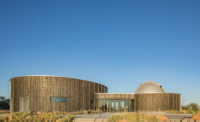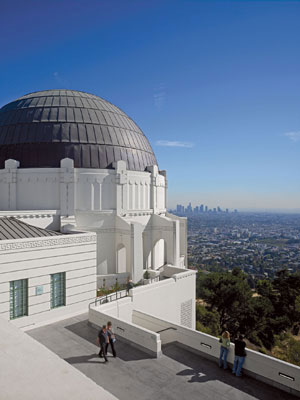Griffith Observatory
Pfeiffer Partners and Levin & Associates Architects' restoration and expansion of L.A.'s beloved landmark lures stars back to Hollywood.

Photo © Tim Griffith

Photo © Tim Griffith

Photo © Tim Griffith

Photo © Tim Griffith

Photo © Tim Griffith

Photo © Tim Griffith

Photo © Tim Griffith

Photo © Tim Griffith

Photo © Tim Griffith

Photo © Tim Griffith

Photo © Tim Griffith

Photo © Tim Griffith

Photo © Tim Griffith

Section

Entrance Level

Lower Level
















Like Los Angeles, the Griffith Observatory, a 1935 Art Deco masterpiece conceived by Russell Porter and designed by the firm Austin and Ashley, exists in several domains, illusory and real. Whether glimpsed in the movies—1955’s "Rebel Without a Cause" or 1984’s "The Terminator"—or as a twilight destination in the Hollywood Hills, the Griffith’s iconic three-domed structure, what longtime observatory director Edwin Krupp calls the “hood ornament of Los Angeles,” also provides that rare Los Angeles accident: true public space.
Angelenos have come to take for granted the drop-dead views of the L.A. basin from the Griffith’s formal, Beaux-Arts plan’s rear terraces and colonnade, as well as the informative, accessible displays of astronomy’s wonders inside. They didn’t foresee that their fondness for the building would wear it out to the point where it would need to close for five years while comprehensive restoration could occur.
Pfeiffer Partners and Levin & Associates respected these convictions when the two L.A. architectural firms collaborated on the preservation and expansion of the observatory during a 10-year, $93 million project. It helped considerably that the two firms’ principals—Pfeiffer’s Steven Johnson, AIA, and Brenda Levin, FAIA—had worked together on some of the most high-profile historic preservation projects in Los Angeles, including the 1993 preservation and expansion of Bertram Goodhue’s 1926 central library (at the time, Pfeiffer was part of Hardy Holzman Pfeiffer).
Johnson and Levin approached the project as a study of dualities—the existing and the new, the iconic and the contemporary, the sky and the ground. Walking up to the building, you would never know the architects had taken the existing 27,000-square-foot building’s cramped galleries and doubled them in size with nearly 40,000 square feet of new underground space.
Due to the 1933 Long Beach earthquake, the original architects eschewed the vogue for a Spanish Revival tile dome, embracing concrete in order, Levin says, to “use materials volumetrically in a clean, modern building,” resulting in a “fortresslike” building that needed no structural upgrades. The high craftsmanship of the original observatory was owed to cheap, Depression-era labor, says Johnson, and it shows in the restored exterior details, heavy bronze window grates, and the marble floor and travertine walls of the rotunda.
Want the full story? Read the entire article in our June 2007 issue.
PeopleOwner Architect Principal-in-Charge: Stephen Johnson, AIA Project Manager (design): David Hart, AIA Project Manager (construction): Edward Carfagno, AIA Project Manager (construction): Steven H. Hall, AIA Historic Architect : Stephanie Kingsnorth, AIA Construction Architect: Lalida P Nakatani, AIA Project Team: Architect of record: Associate architect(s): Principal: Brenda Levin, FAIA Project Architect: Robert Knight Project Team: Interior designer: Interiors: Kate Bowman Engineer(s): Principal : Ken Wong, S.E. Mechanical/Electrical/PlumbingEngineers: Mechanical Project Manager: George Lui Electrical Project Manager: John Neshek Construction Administration: Scott Goroon Consultant(s): Project Manager: Tom Chacon Civil Engineer: Principal: Jose M. Gama Lighting: John Dunn Acoustical & Audio-visual: C&G Partners LLC 116 East 16th Street New York, NY 10003 www.cgpartnersllc.com Principal: Jonathan Alger Senior Designer: Kevin Sayama Graphics:Amy Siegel Theater/Planetarium Audio-Visual: S. Leonard Auerbach, President Exterior Envelope Conservator: Carolyn Searls Murals Conservator: Leslie Rainer Murals Conservator Analyst: Tatanya Thompson Paint Conservator: Martin Eli Weil Metals conservator: Donna Williams General contractor: Project Manager: Kevin Clounch Contractor’s Conservator: Linnea Dix Dawson Photographs © Tim Griffith Tim Griffith 415-640-1419 tim@timgriffith.com www.timgriffith.com
CAD system, project management, or other software used: AutoCad 2000, Adobe Illustrator, Microsoft Excel |
ProductsStructural system: Exterior cladding: Waterproofing: Bentonite Roofing: Built-up roofing: Sarnafil Elastomeric: Other: Cetco Self-Adhesive Membrane Windows: Glazing: Glass- Vitrines: Viracon Glass Insulation: Owens Corning Doors: Metal doors: Milcor Wood doors: Nikolai Hardware: Hinges: Julius Blum Company, Inc. Closers: Rixson Exit devices: Von Duprin Pulls: Trimco Security devices: Pelco Cabinet hardware: Julius Blum Company, Inc. Interior finishes: Stretch fabric ceiling system in first floor exhibit halls: Eurospan Acoustical ceilings: Tectum Inc., Ceiling Plus, Ecophon Suspension grid: Decoustic, Armstrong Wall Tile: Ann Sacks Wall/Floor Tile: Dal Tile Rubber Flooring: Johnsonite Cork Flooring: Duro-Design, Expanko Cork Company Paints and stains: Scuffmaster, Tnemec, Sherwin Williams Wallcoverings: Wall Technology Paneling: Haver & Boecker from Architectural Material Resources,Gordon Metals Plastic laminate: Formica, Johnsonite, Nevamar Special surfacing: Armour Coat, Venetian Plaster Floor and wall tile: Terrazzo: Corradini Corp Resilient flooring: Stonhard Custom glazing covering: 3M Scotchcal Carpet: Prince Street Furnishings: Fixed seating: Knoll Textiles, Seating Concepts Upholstery: Mechoshade System Inc. Other furniture:Toilette partitions: Surrel by Formica Corp. Lighting: Downlights: Translite: Sonoma; Translite: Ardee Task lighting: Cooper Lighting, Bartco, Birchwood, Lightolier Exterior: Luminaire, B-K Lighting, Cole Lighting, Hevlite Controls: Lutron Conveyance: American Standard Waterfountains: Filtrine
|




















